
Above is a picture of one of my latest guitar acquisitions. It started life as a neglected Gibson LG-1 flattop acoustic that I picked up in July 2017 from a Facebook music instrument for sale group. The guitar was being sold by a local musician for the wife of a late friend who was also a musician in Cedar Rapids. He had it listed as “Make an Offer.” He had sent photographs and the serial number off to Gibson to get it dated. Based on the serial number of X9112 24 stamped on the inside and the teardrop pickguard, they estimated it to be a 1954.
The guitar was bought in the early 1970’s when his friend worked at Carma Lou’s House of Music, which was a long-standing music store in Cedar Rapids. I think I’m likely the third owner of this guitar.
It apparently languished in its guitar case under a bed for a long time because the plastic tuning keys had denatured which made them very brittle and had mostly crumbled off. What apparently happens is that the plastic off-gases as it ages and because it was locked in its case, those gases couldn’t escape. As a result the guitar couldn’t be tuned.

In addition to that, one of the braces was missing from the inside, and the rosewood bridge was pulling away from the top, which also caused a bulge. The guitar was not playable in its current state, so a decision needed to be made. What is the goal? I could have bought it and just hung it on a wall somewhere. Maybe replace the tuner keys. Or, I could have had the guitar restored by a luthier. Replace the tuners, glue in another brace, fix the bridge. I reached out to my friend Scott Baxendale of Baxendale Guitar. Scott is a renowned guitar luthier and has created guitars for a lot of musicians including the guys from The Drive-By Truckers. I know Scott from when I helped him promote a record he made with Jack Logan. He has a business where he takes “learner guitars” or cheaper acoustic guitars from the 40’s through the 60’s and completely refurbish them he calls Baxendale Conversion (It was called Harmony Conversion at the time, after the Harmony guitars of this period). His team takes the guitar completely apart, upgrades the interior bracing from a ladder style bracing to a cross-bracing based on 1920’s Martins. They then do a complete re-fret and re-radius the fretboard to a 12″ or 14″, replace the bridge with a newly created one and install a bone nut and saddle. They install period correct upgraded tuners as well. They put the guitar back together and adjust the neck for perfect intonation, making it a guitar, that in his words will sound and play better than a vintage guitar that costs ten times as much. The key to this is that even inexpensive guitars from this period used good tonewoods. So, you get a nicely aged guitar but upgraded. I saw a couple of videos on YouTube of folks who had this done and I had my decision made– I’d do a conversion on the guitar. As much as I would have loved to have a 1950’s Gibson that was restored to original specs, this guitar had a lot of work needing to be done and LG-1’s aren’t really that desirable because they were the cheapest of the LG’s at that time and you can get really nice examples for around $1300 currently. The conversion process changes the ladder bracing to cross bracing, which essentially makes them like the more desirable LG-2. Vintage LG-2’s are going for over $3000 in very good condition on Reverb with pre-war examples above $6,000!
Some background on the Gibson LG-1 from Reverb’s page on them: “During World War II, Gibson pared its flat-tops down to six standard models, the Gibson LG-1 acoustic guitar among them. As a student model, the LG-1 was introduced alongside the LG-2 and LG-3 to be a less expensive model that even younger players could afford. Because it was initially intended to be a lower-end guitar, the LG-1 uses ladder-style bracing and is made of a mahogany back with a spruce top.”
In a kind of Baader-Meinhof version of musical gear ownership, I started seeing LG guitars everywhere where I hadn’t noticed them before. It seems that the LG’s are a popular choice for working acoustic guitar players– at least among the players I pay attention to. Here are some examples of players:
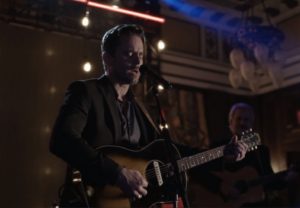
The ABC/CMT TV show Nashville was a worthwhile watch if only for the incredible stable of guitars the show had. Prop Master Danny Rowe was interviewed by Gibson for their website and shed some light on the guitars, and mentioned two LG-2’s on the show:
“Sam Palladio, who plays Gunnar Scott, has an LG-2. I had that guitar recreated It’s been in the Country Music Hall of Fame as a flagship for the show and now it’s on its way to Disney World. That guitar has stayed with his character and been a part of what he does. And Chip [Charles Esten] has played quite a few. His character Deacon Claybourne has an Advanced Jumbo that he plays in his living room or on his front porch. A character like his would own a whole bunch of guitars, so he’s also played L-00s, ES-125s, and an LG-2 with a pickup and a J-200.“
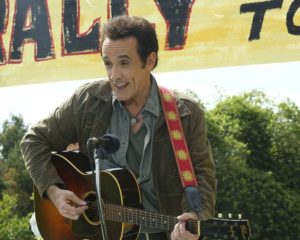
Another TV show that featured an LG prominently was ABC’s The Middle. The youth minister Reverend Tim Tom played by actor Paul Hipp wields a 1943 “banner” logo Gibson LG-2. I messaged Hipp through his fanpage on Facebook about the guitar.
“It is indeed a 1943 Gibson LG-2. I bought the guitar at Matt Uminov on Bleeker St in The Village in 1990. It has an amazing and balanced tone. I walked into the shop and heard the salesman talking to another guy about it and that “Bob” had been in the day before and tried and loved it… blah blah…. probably all salesman bullshit I thought… but I figured I’d give it a strum just for the hell of it… one strum and SOLD. Been loving it ever since.”
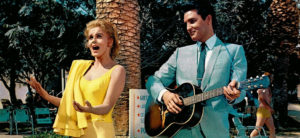
According to guitar legend Scotty Moore on his website, the Gibson LG-1 was used in more of Elvis Presley’s films than any other guitar, featured prominently in his MGM films from 1963-1968. Moore’s page on the LG-1 gives a lot of good information about the LG-1 in general in addition to many photographs of Elvis from the films. Based on Moore’s research, there was at least two LG-1’s in the prop department at MGM. These are 1955 or newer because they have the larger (not teardrop) pickguards. Unfortunately, one of the LG-1’s ends up in a swimming pool in the debut scene of Viva Las Vegas (for a few takes it seems) which would have really trashed the guitar. In later movies starting with the 1966 film Spinout, one of the LG-1’s gets a mustard colored paint job– Moore guesses it might be the pool victim.
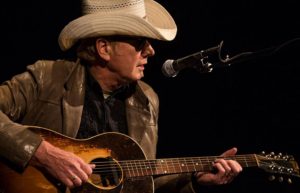
There are a few musicians with roots in Eastern Iowa who play mid-century LG’s and they are all related to Bo Ramsey it seems. Bo has an early 1950’s LG-2 that he said to me in an email is a “honey dog.” What a fantastic way to describe the tone! According to an interview with his wife Pieta Brown, she played that guitar on her album Mercury.
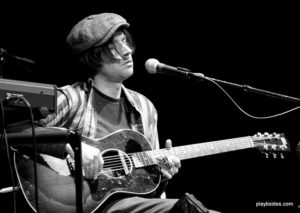
I’ve been following The Pines since their first self-titled album in 2004. Their atmospheric take on folk and blues is unique and every album is a stunner. They’ve taken the template laid down by Bo Ramsey and run off in their own direction. Benson and Alex Ramsey are sons of Bo. Benson is a guitarist and he plays a script-logo LG-2. This dates the guitar from 1943-1947. But, since it doesn’t have the banner on the headstock, it could be a 1946 or 1947. In 1948 Gibson changed the logo to the “block” design. Gibson has in recent years reissued the LG-2 as the “American Eagle” (natural finish with block logo) and the “Americana” (burst finish with script logo). I’ve never talked to Benson about the guitar, so I don’t know if it is an original or if it is the reissue. It has black plastic string pegs and the reissue has white ones, so maybe it’s an original one.
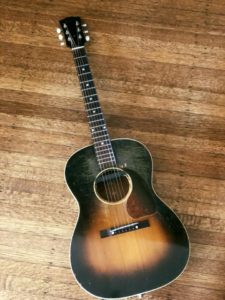
Kelly Pardekooper started out as an Iowa musician and bounced around a bit before settling in Las Vegas. Bo Ramsey has produced a few of his records over the years including his 2018 album 50 Weight. Kelly posted this picture of his 1952 LG-1 to his Facebook feed around the time they were recording the album at Flat Black Studios in Iowa. I hadn’t seen the guitar before so I asked him about it. “This is my LG1. Not surprisingly Bo helped me find this one at Willie’s Guitar in Minn back in ‘07. It’s a sweet one..Use it mostly for recording and writing.”
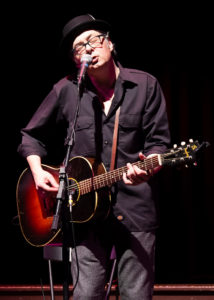
A recent LG spotting I had was when Kevin Gordon played at CSPS. Gordon spent a few years in Iowa getting his Master’s degree in writing at the University of Iowa in the early 90’s. During that time he also was in Bo Ramsey’s band The Sliders. Gordon brought a collection of unique guitars with him and among them was a “banner” script logo LG-2. Banner logo Gibson acoustics were manufactured during World War II when the Kalamazoo factory hired skilled women to build the guitars. Many say that this was the pinnacle period for Gibson acoustics.
Recently Gordon posted a picture of the guitar to Facebook with the note, “Been a good friend for 25 years—my Gibson LG-2, which far as I can tell dates to 1943 or so. Replacement bridge was there when I bought it in Austin way back. Came with non-original (50s era?) cardboard case. A good traveler (except for that case).”
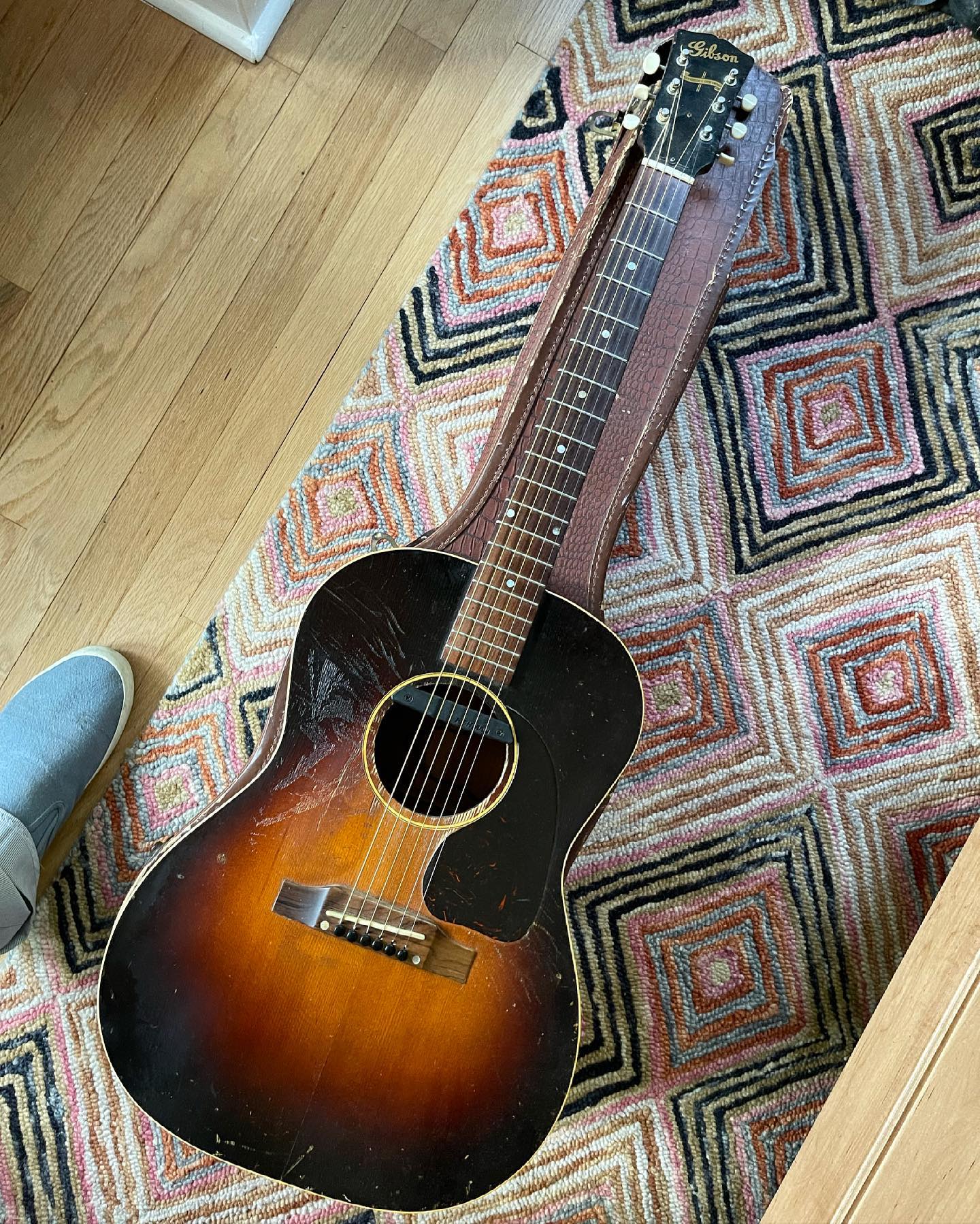
Chris Stapleton has been interviewed a few times about his LG-2 which he paid around $380 for and spent another $900 getting it to where it is today. It needed new tuners and a new neck, but is his primary songwriting guitar.
After I bought the guitar from the seller I made the arrangements with Scott and ordered a nice and inexpensive chipboard case from Musician’s Friend and shipped it to Athens, GA (where he was located at the time). Scott said it would take at least three months before I’d get it back. I watched his Instagram feed with interest to catch a glimpse of my guitar being worked on. On October 27th Scott posted a picture of an LG with scratches I recognized instantly. I got a shot of the guitar in disassembly which was great and I got an interesting bit of history about the guitar. It got a new top at some point in its life– likely at the factory, so the dovetail tenon is hidden under the top rather than cut around it.
After some time with the guitar, I think it was the right choice to have the guitar “resto-modded” (to borrow a car culture expression). It plays beautifully and is surprisingly loud for such a small guitar! It projects as much as my Taylor dreadnaught. The neck is incredible and the guitar itself is really light.
Certainly I’m not comparing myself to the musicians who use Gibson LG’s, but it’s cool to see a community of players who all like the LG-1 and LG-2’s and it makes my own LG project that much more special. The guitar is 70 years old in 2024, which is kind of mind-blowing and with the proper care, this guitar should make it past 100 years (and I’ll be in my 80’s if I make it that long). My grandson would be in his late 30’s for that, it would be great to hand this to him and continue its journey into its second century.
